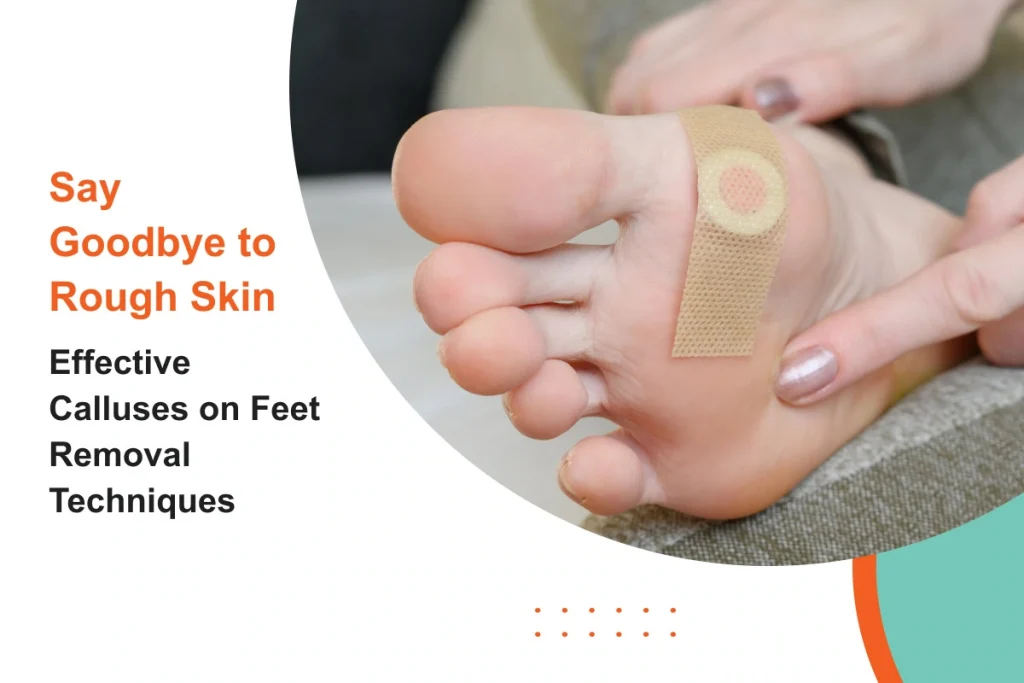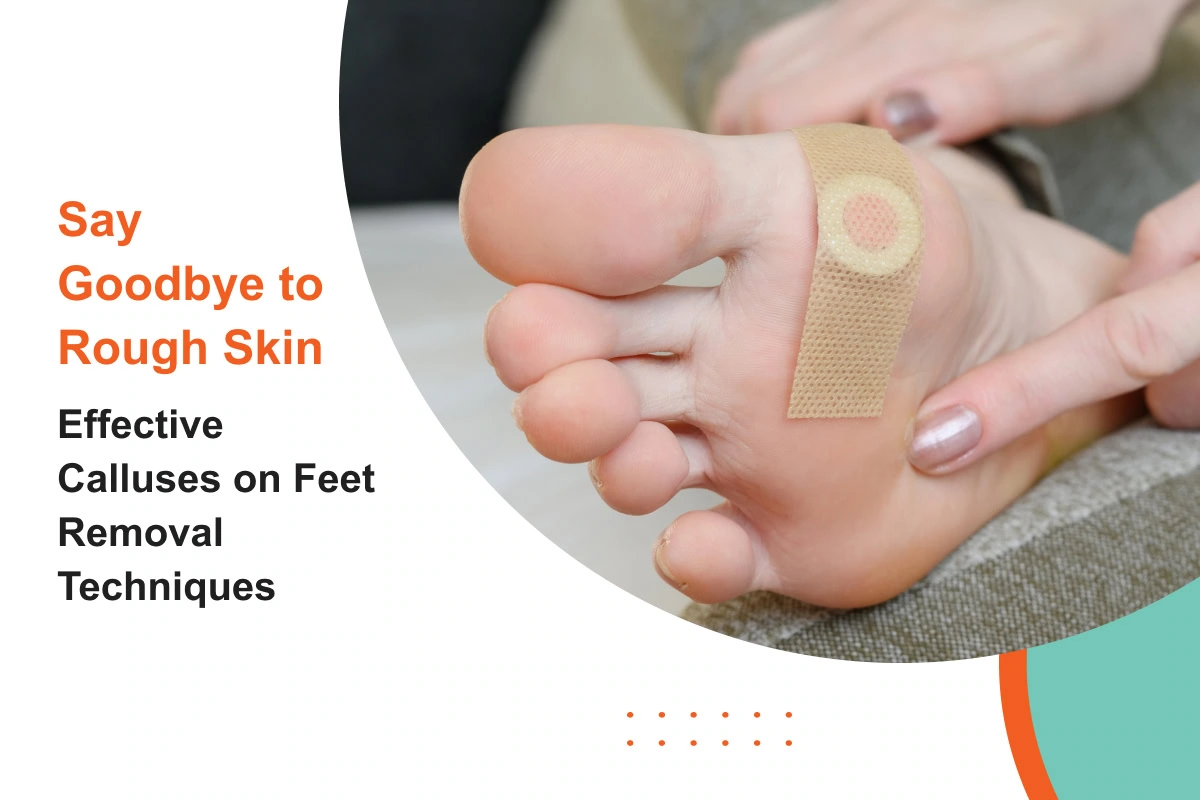
According to podiatrists, calluses on the feet are one of the most common conditions seen in clinical practice. These hardened areas of skin develop when the feet are exposed to repeated pressure or friction. While they often serve as a protective response, calluses can become unsightly, uncomfortable, and even painful. Many patients seek effective methods for treatment and prevention, whether through home remedies or professional care.
This article summarizes how podiatrists explain corns and calluses, their causes, and the safest approaches for calluses on feet removal. It also highlights practical strategies for long-term prevention and improved foot health.
Understanding Corns and Calluses
Podiatrists emphasize that while the terms are often grouped together, corns and calluses are not identical conditions:
- Corns: Small, round, and often tender or painful. These typically develop on the tops or sides of the toes. Corns can be hard (from pressure) or soft (from moisture and friction between toes).
- Calluses: Larger, flatter patches that usually appear on the bottoms of the feet, especially on the heels or balls of the feet. They are often painless but can cause discomfort when they grow thicker.
Both involve a buildup of dead skin in varying sizes and shapes. While they develop as a defense mechanism, untreated corns and calluses may progress to pain, cracked skin, or infection.
Causes of Calluses on Feet
Podiatrists stress that identifying the cause is as important as treatment. Common triggers include:
- Poorly fitting shoes that are too tight or too loose, creating friction.
- High heels or narrow footwear that concentrates pressure on the toes and forefoot.
- Walking barefoot on hard surfaces, which encourages protective thickening.
- Foot structure issues, such as flat feet, bunions, or high arches, that alter weight distribution.
- Repetitive activities like prolonged standing, running, or certain sports.
- Improper socks, especially thin socks or going without, which increases rubbing from shoes.
Without addressing these underlying factors, even the most effective calluses on feet removal methods will only provide temporary relief.
Home Remedies for Calluses
For mild cases, podiatrists often recommend starting with calluses at home treatments. These methods are inexpensive, safe, and effective when performed consistently.
- Soak and Soften: A simple soak in warm soapy water for 10–20 minutes softens thickened skin, making it easier to remove. Adding Epsom salt can provide additional soothing benefits.
- Gentle Exfoliation: After soaking, patients are advised to rub the corn or callus with a pumice stone or use an emery board for smaller spots. This gradually reduces hardened, dead skin. Aggressive scraping, however, should be avoided to prevent injury.
- Moisturize Daily: Podiatrists frequently recommend creams or lotions containing salicylic acid, ammonium lactate, or urea. These agents promote skin softening and the gradual breakdown of callused tissue. A thin layer of petroleum jelly after moisturizing helps seal in hydration and protect calluses from cracking.
- Cushion and Protect: Pads, cushioned socks, or non-medicated callus pads reduce friction from wearing shoes while the area heals.
Additional Home Remedies
- Applying a thin coat of petroleum jelly and wearing cotton socks overnight hydrates the skin.
- Vinegar soaks, followed by gentle filing, may also help.
- A baking soda paste applied for short periods can loosen dead skin.
Over-the-Counter Callus Removers
When home care alone isn’t enough, podiatrists may suggest callus removers available at pharmacies:
- Medicated pads with salicylic acid, which dissolve layers of skin gradually.
- Creams with ammonium lactate, which promote skin softening.
- Foot files or scrapers, which provide controlled removal of thick skin after soaking.
- Podiatrists caution patients to follow product directions carefully, since overuse can irritate healthy areas of skin.
Professional Callus Treatments
When calluses are persistent, painful, or recurrent, podiatric care becomes essential. A podiatrist may recommend:
- Debridement: Safe trimming of excess dead skin using sterile instruments.
- Prescription creams: Higher-strength formulas with salicylic acid or urea.
- Custom orthotics: Inserts designed to correct abnormal pressure from poorly fitting shoes or structural imbalances.
- Surgical correction: Rare, but occasionally necessary if bone alignment causes recurring callus formation.
Professional care ensures safe and thorough calluses on feet removal, particularly for patients with diabetes, neuropathy, or circulation issues.
Prevention: The Key to Long-Term Relief
Podiatrists emphasize that successful treatment must be paired with prevention. Recommended habits include:
- Wearing properly fitting shoes with adequate toe room and arch support.
- Alternating shoes to reduce repetitive pressure in the same spots.
- Using cushioned socks to absorb friction.
- Daily moisturizing with creams or lotions containing urea or ammonium lactate, followed by a coat of petroleum jelly.
- Protecting high-friction spots with pads or inserts.
- Maintaining good foot hygiene, including washing and trimming nails regularly.
These strategies not only help patients rid of calluses but also improve overall foot health.
Myths About Calluses
Podiatrists frequently encounter misconceptions, such as:
- Cutting calluses at home is safe. In reality, this increases the risk of infection.
- Ignoring calluses is harmless. Untreated, they often worsen, crack, or cause pain.
- Home remedies alone always work. While effective for mild cases, moderate to severe calluses usually require podiatric care.
Calluses vs. Other Foot Conditions
Accurate diagnosis is important. Conditions often mistaken for calluses include:
- Plantar warts, which are viral, often display black pinpoint dots, and hurt when squeezed.
- Athlete’s foot, a fungal infection that causes itching and peeling, not thickened skin.
- Blisters, fluid-filled sacs that differ from hardened calluses.
Podiatrists stress the value of proper identification to ensure correct treatment.
How Long Does Calluses on Feet Removal Take?
The timeline depends on severity:
- Mild calluses: Often improve in a few days with soaking, filing, and moisturizing.
- Moderate calluses: May take several weeks of consistent care with salicylic acid or ammonium lactate.
- Severe calluses: Require podiatric debridement for faster relief.
Ongoing care is critical—even after removal—to prevent recurrence.
When to Seek Medical Attention
Patients are advised to see a podiatrist if:
- Calluses are painful or interfere with walking.
- Redness, swelling, or pus suggest infection.
- There is a history of diabetes, neuropathy, or circulation problems.
- Calluses return despite proper care.
Prompt evaluation ensures safe and effective management.
A Daily Foot Care Routine
Podiatrists often recommend this routine to reduce recurrence of corns and calluses:
- Morning : Apply moisturizing creams or lotions before putting on socks.
- Daytime : Choose well-fitting shoes with proper support and cushioned socks.
- Evening : Wash with warm soapy water, dry thoroughly, and apply petroleum jelly.
- Weekly : Exfoliate gently with a pumice stone or emery board.
Following this routine makes calluses easier to remove and less likely to return.
Conclusion
From a podiatrist’s perspective, calluses on feet removal requires both treatment and prevention. Safe strategies include soaking in warm soapy water, exfoliating with a pumice stone or emery board, moisturizing with salicylic acid or ammonium lactate, and sealing in moisture with petroleum jelly.
Professional podiatric care is the safest option for stubborn or painful cases. Preventive measures—such as wearing shoes that fit, daily moisturizing, and protecting high-friction areas of skin—remain the best long-term defense.
By managing and protecting the feet with these approaches, patients can not only rid of calluses but also maintain comfort, mobility, and overall foot health.



